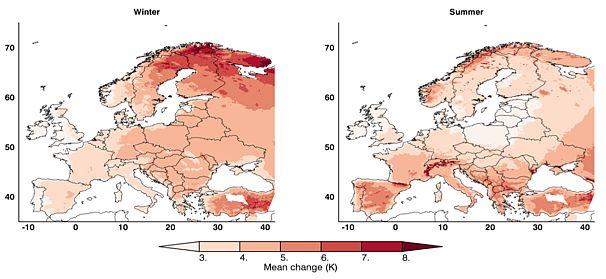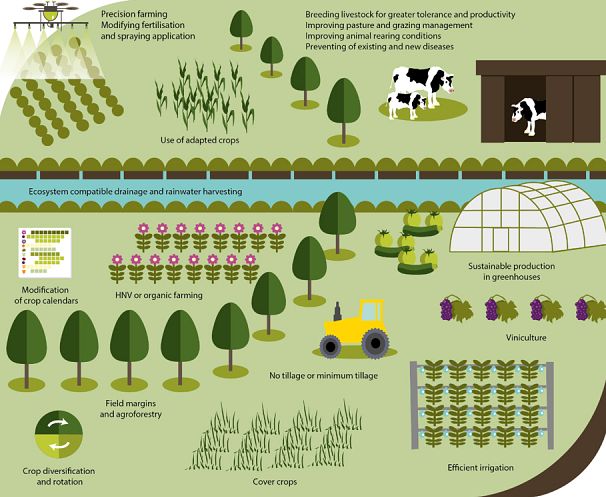First there was the wave of cold Siberian air that hit olive groves across Italy.
Then came the scorching summer, with its extreme temperatures and shortage of rains. October and November followed with floods and excessive rains. According to the professional magazine Olive Oil Times, in 2018, Italy lost about 57 percent of its olive production, with other crops and fruit trees also affected. Spain followed in 2019, when drought compromised 44 percent of its production.
“Changes in temperature and precipitation, as well as weather and climate extremes are already influencing crop yields and livestock productivity in Europe,” says Blaž Kurnik, expert on climate change impacts and adaptation at the European Environment Agency. “Projections show an increase in extreme weather and climate events across the continent. Farmland value is projected to decrease by more than 80 percent by 2100 in some regions in southern Europe, which could lead to agriculture land abandonment,” says Dr. Kurnik.
A strong impact of climate change on future crops
Last January, the Copernicus Climate Change Service (C3S) announced that 2019 was the fifth in a series of exceptionally warm years and the second warmest year globally ever recorded. Meanwhile, Europe saw its warmest year on record by a small margin. While waiting for the release of its 2019 European State of the Climate report due in April 2020, the 2018 report already indicated that temperatures in Europe showed a clear warming trend over the last four decades, for both annual and seasonal averages. 2018 was one of the three warmest years on record for Europe - together with 2014 and 2015 - with an anomaly of around +1.2°C relative to 1981-2010.
Rainfall in northern Europe has increased by up to 70 mm/decade since the 1960s, while in the south, it has dropped by up to 90 mm/decade, according to research from HHFA, a consultancy. Forecasts say that climate change will undermine agriculture in many parts of Europe, Kurnik explains. “The most affected regions are projected to be in the Mediterranean and in south-eastern Europe, mainly due to decreases in rain and higher temperatures, both resulting in longer and intensive droughts, and water scarcity,” says Kurnik.
Heavy rain affecting crops and flooding agricultural land might also rise by up to 35 percent in central and eastern Europe, according the a recent European Environmental Agency (EEA) report. But rising temperatures have been allowing crops to expand northwards in the last 40 years; predictions say that shift will continue, and yields have potential to increase.
Each crop needs a specific combination of conditions to reach full potential; their cycles are tuned to specific events happening at specific times, so whenever things go off track, crops react. Higher temperatures nudge crops to grow earlier and develop faster. Cereals such as wheat and maize are expected to flower and mature one to three weeks earlier, especially in western and northern Europe, says the EEA.
 The time has come for the EU to engage with African agriculture
The time has come for the EU to engage with African agriculture
But warmer temperatures pushing crops to grow quicker don’t give them sufficient time to accumulate enough biological material, which can make them less productive; maize, wheat and barley yields have already been affected in southern-central Europe. In the future, corn yields in Portugal might drop by 20 to about 29 kg/ha/year between 2051-2080, while some studies warn that the quality of Spanish wine grapes might suffer.
“Extreme events during flowering are especially dangerous for many crops, for instance, cereals,” says Dr. Margarita Ruiz Ramos, expert in agricultural systems’ adaptation to climate change at CEIGRAM. “This is the case of heat and drought in the Mediterranean, which could now happen also occasionally in central Europe”, says Dr. Ramos.
In 2010, the summer heatwave in Russia compromised 30 percent of its grain harvest; Russian authorities limited the damage by banning wheat exports, which spiked up global wheat prices. In the last decade, weather and climate extreme events linked to climate change have cost Italy’s agriculture and rural infrastructure about 14 billion euros, according to Coldiretti, Italy’s leading farmers’ union. Sardinia, where average temperatures this winter have been 3° C higher than usual, and where long droughts alternate with extensive floods, is risking a serious drop in cereal yields in the next 30 years, according to Meteonetwork’s expert Allesandro Gallo. The EEA estimates that most of Portugal, Galicia, northern
Scandinavia, and Turkey will face harsher droughts; if global temperatures increase by 2°C, rising water deficits in Cyprus, Greece, Italy, and Spain will push up demand for irrigation water between 4 and 18 percent by 2100.
“Other extreme events related to flooding or too much water in the soil during sowing and harvest can also be a problem in parts of central and northern Europe,” Ruiz-Ramos adds. “In the north, although the growing season may increase, new pests and diseases can jeopardise the potential for higher crop yields.”
Adaptation under way with the help of climate data
“The sector’s adaptation to climate change will be crucial; successful planning and implementation of the adaptation policies at various levels is important,” says Dr. Kurnik.
But farmers are already adapting. On the island of Sicily, tropical fruit crops such as mangoes, papayas or lychees have become part of landscape, as farmers are capitalising on the warmer conditions. In Spain, 64.7 percent of farmers have already changed how they managed crops, especially their water use, one survey showed. “They’re investing in more efficient irrigation systems, transitioning from a full irrigation approach to watering only in key moments,” says Dr. Ruiz-Ramos. “Spanish farmers are also changing sowing dates and crop varieties to match crops’ life-cycles and the weather, while adjusting how much fertiliser they use,” adds Dr. Ramos.
Providing climate data that is useful for farmers is crucial for adapting Europe’s agriculture to weather and climate extremes. Several programmes within the Copernicus Climate Change Service (C3S) are tailoring their climate data and models to help agriculture respond better to climate change. The Copernicus Climate Change Service aims to provide data in almost real time to help daily farming decisions and assessing crops. “Food security is a global concern, and the effect of climate on agriculture cannot be isolated to a single country or region,” explains C3S Director Carlo Buontempo. “We provide data that can be fed into crop models, as well as a number of indicators relevant to the sector.” This includes historic and current data, as well as future climate, crop, and water indicators and statistics.
Examples of adaptation using climate data are on the rise. In Italy’s district of Castiglione, GECOsistema, a consultancy, used C3S data to help a regional land and water authority plan sustainable irrigation strategies; using climate scenarios for 2020, 2050 and 2080, they linked projections of water supply to yields for six crops, including kiwis, peaches, and corn.
“The current project has a more global focus, and has been expanded to include indicators for wheat, rice, soybean and maize,” explains Ronald Hutjes, Associate Professor and project lead at Wageningen University and Research, the leading partner developing this global service.
In Tuscany, Agricultural Climate Advisory Services used C3S climate predictions to project how a pest insects will affect olive trees under changing climate conditions. It showed that warmer winters can favour pests and threaten olive yields, information that can help farmers adjust their operations.
Adapting crop productivity to changing climates also relies on selecting plant varieties that can withstand better weather hazards and climate variability, explains Dr. Ramos. The International Maize and Wheat Improvement Center (CIMMYT) is using C3S data to improve crops; by looking at how the plants perform in various weather conditions, researchers focus on selecting cereal varieties resilient to drought and heat.
One of Portugal’s main port wine producers is testing a climate application meant to improve the vineyard’s resilience to climate change. The Vineyards Integrated Smart Climate Application (VISCA), an EU initiative, combines climate, agriculture and farmer-specific information to adapt crop planning to climate change. Crop forcing, one technique used, involves moving the ripening time from hot summer months to later, cooler months, by extra pruning, halting the vine’s natural cycle and forcing it to start it later.
Bringing climate data to small farmers is a challenge and a pilot adaptation project in Kenya is a good example of this. “We translate climate data to fit the needs of the farmers and extension workers that support them, using easy to understand visualisations,” says Dr. Hasse Goosen, director of Climate Adaptation Services. “We translated C3S data to crop-specific indicators and have developed story lines, supported by maps, to explain how and when throughout the season will specific crops be impacted.” The project also provides a tool for creating maps for certain variables influencing crops.
Using climate data is also key for helping to shield farmers against losses from extreme weather. “We use weather data to model risks,” says Alexa Mayer-Bosse, business development manager at MunichRE, an insurance company serving the agro sector. “With satellite technology and digitalization becoming more prevalent, there is continuously more data available as a proxy for agricultural risks. Based on these data sets, insurance products can be tailored to climate parameters”.

















